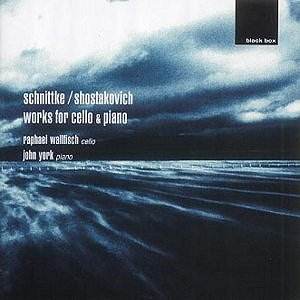How do you feel about music originally conceived
for one instrument being arranged for another? Franck’s Violin
Sonata for cello is one example. If you don’t mind then this Shostakovich
Cello Sonata written originally for violin will not bother you.
It was the master’s last will and testament as it were, and so
cellists would like to claim it as well as fiddlers. But I’m not
so sure. Textures originally conceived as mostly treble-orientated
are now differently balanced for example in the second movement.
The Allegretto the opening seems to have lost its wittiness and
ghostly humor by being somewhat sluggish in tempo and at least
an octave lower.
Surely there is enough for cello not to warrant
such arrangements. This one is by Daniil Shafran. Nothing is said
about him in the booklet notes but he was born in Leningrad in
1923 and is well known especially in Russia as a virtuoso cellist.
I must add that it is mostly a very fine piece of work and obviously
done from the heart. But as Stravinsky often said "Do we
need it?"
The other works by Shostakovich are miniatures.
The elegiac Moderato of 1934 is in the style of the eloquently
lyrical extracts we hear in the ‘Gadfly’ incidental music. The
Adagio of 1951 is in a similar vein and was (to quote John York’s
booklet notes) "lifted from one of Shostakovich’s ballet
suites by Lev Atovmyan, and presents a glamorous theatrical big
tune".
The Shostakovich sonata lasts over half an hour
and the two by Schnittke last about 23 minutes and 15 minutes
each but seem to be even more portentous and weighty due to their
elegiac and tragic nature. This is despite the fact that they
appear somewhat detached from reality and conventional formal
structures. Having said that, the 1st Cello Sonata,
in which Schnittke found his real musical self is in three movements:
Largo, Presto (which acts as a scherzo) and a closing Largo, is
not a totally unexpected form. The opening Largo could be seen
as an introduction to the much longer Scherzo which in turn burns
itself out and dissipates its energies into a finale. This is
a threnody, which is the length of the first two movements put
together.
The Second Cello Sonata, written after Schnittke
had had a series of heart attacks is a valedictory work which
is as elusive as is it fragmentary. It was written just before
the equally elusive 3rd Piano Sonata. Perhaps one might
be put in mind of some of the last works of Britten, say the 3rd
String Quartet, except that Schnittke is totally pessimistic even
nihilistic in outlook and in final result. Its five movements,
the longest at no more than four and a half minutes, make up what
might be considered a suite. It begins with an introductory section
marked ‘senza tempo’, leading into an Allegro, then comes the
longest movement, a Largo, followed by another even briefer, fleeting
Allegro relaxing into a kind of desiccated Lento. It is here that
I, for one, cannot cope with this music any more. It probably
speaks with great reality and is certainly penetrating and uncomfortable
but as in all late Schnittke there is little else to add. When
does it ever smile? I can’t help but feel that its totally inward-looking
nature achieves little more than generating sympathy. And yet
and yet … perhaps we are too close to it to judge. Something nags
away at me that this is probably great music and I am somehow
missing the point.
Certainly these pieces could not have better
advocates than John York and Raphael Wallfisch. York is a very
fine musician first and foremost. His regular work on contemporary
music is a quiet and vital part of out cultural life, little recognized.
Raphael Wallfisch is a great cellist and they both believe in
this music and transport the bare notes on the page into something
beyond time and space. Recording quality, of this generously filled
disc, is first class.
Quite an achievement by all concerned.
Gary Higginson
